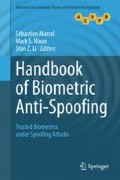Abstract
Iris images contain rich texture information for reliable personal identification. However, forged iris patterns may be used to spoof iris recognition systems. This paper proposes an iris anti-spoofing approach based on the texture discrimination between genuine and fake iris images. Four texture analysis methods include gray level co-occurrence matrix, statistical distribution of iris texture primitives, local binary patterns (LBP) and weighted-LBP are used for iris liveness detection. And a fake iris image database is constructed for performance evaluation of iris liveness detection methods. Fake iris images are captured from artificial eyeballs, textured contact lens and iris patterns printed on a paper, or synthesised from textured contact lens patterns. Experimental results demonstrate the effectiveness of the proposed texture analysis methods for iris liveness detection. And the learned statistical texture features based on weighted-LBP can achieve 99accuracy in classification of genuine and fake iris images.
Access this chapter
Tax calculation will be finalised at checkout
Purchases are for personal use only
References
Ruiz-Albacete V, Tome-Gonzalez P, Alonso-Fernandez F, Galbally J, Fierrez J, Ortega-Garcia J (2008) Direct attacks using fake images in iris verification. In: Schouten B, Juul N, Drygajlo A, Tistarelli M (eds) Biometrics and identity management, vol 5372., Lecture Notes in Computer ScienceSpringer, Berlin Heidelberg, pp 181–190
Schneier B (1999) Inside risks: the uses and abuses of biometrics. Communications of the ACM 42(8):136
Schuckers SAC (2002) Spoofing and anti-spoofing measures. Inf Secur Tech Rep 7(4):56–62
Thalheim L, Krissler J, Ziegler P (2002) Body check: biometrics defeated’c’t magazine. June 3, 2002
Matsumoto T (2004) Artificial irises: importance of vulnerability analysis. In: Proceedings of Asian biometrics workshop (AWB), vol. 45
Szwoch M, Pieniazek P (2012) Computer Vision and Graphics. Eye blink based detection of liveness in biometric authentication systems using conditional random fields. Springer, Berlin, pp 669–676
Adler F (1965) Physiology of the eye: Clinical application the cv mosby company
Davision H (1962) The eye. Academic, London
Huang X, Ti C, Hou Qz, Tokuta A, Yang R (2013) An experimental study of pupil constriction for liveness detection. In: IEEE Workshop on Applications of Computer Vision (WACV), pp 252–258
Puhan N, Sudha N, Suhas Hegde A (2011) A new iris liveness detection method against contact lens spoofing. In: IEEE International Symposium on Consumer Electronics (ISCE), pp 71–74
Daugman J (2003) Demodulation by complex-valued wavelets for stochastic pattern recognition. Int J Wavelets Multiresolut Inf Proc 1(01):1–17
Lee E, Park K, Kim J (2005) Fake iris detection by using purkinje image. In: Zhang D, Jain A (eds) Advances in biometrics, vol 3832., Lecture Notes in Computer Science.Springer, Berlin Heidelberg, pp 397–403
Galbally J, Ortiz-Lopez J, Fierrez J, Ortega-Garcia J (2012) Iris liveness detection based on quality related features. In: IAPR International conference on biometrics (ICB). IEEE pp 271–276
He X, An S, Shi P (2007) Statistical texture analysis-based approach for fake iris detection using support vector machines. In: Lee SW, Li S (eds) Advances in biometrics, vol 4642., Lecture Notes in Computer Science.Springer, Berlin, pp 540–546
Wei Z, Qiu X, Sun Z, Tan T (2008) Counterfeit iris detection based on texture analysis. In: International conference on pattern recognition (ICPR), pp 1–4
He Z, Sun Z, Tan T, Wei Z (2009) Efficient iris spoof detection via boosted local binary patterns. In: Tistarelli M, Nixon M (eds) Advances in biometrics, vol 5558., Lecture Notes in Computer Science.Springer, Berlin, pp 1080–1090
Zhang H, Sun Z, Tan T (2010) Contact lens detection based on weighted LBP. In: International conference on pattern recognition (ICPR), pp 4279–4282
Doyle JS, Flynn PJ, Bowyer KW (2013) Automated classification of contact lens type in iris images. In: IAPR International conference on biometrics
Doyle JS, Bowyer KW, Flynn PJ (2013) Variation in accuracy of textured contact lens detection based on sensor and lens pattern. In: IEEE International conference on biometrics: theory applications and systems (BTAS), pp 1–6
Lee SJ, Park KR, Kim J (2006) Robust fake iris detection based on variation of the reflectance ratio between the iris and the sclera. In: Biometrics symposium: special session on research at the biometric consortium conference 2006:1–6
Lee SJ, Park KR, Lee YJ, Bae K (2007) Multi-feature based fake iris detection method. Opt Eng 46(12):127–204
Chen R, Lin X, Ding T (2012) Liveness detection for iris recognition using multispectral images. Patt Recogn Lett 33(12):1513–1519
Connell J, Ratha N, Gentile J, Bolle R (2013) Fake iris detection using structured light. In: IEEE International Conference on Acoustics, Speech and Signal Processing (ICASSP), pp 8692–8696
Haralick R, Shanmugam K, Dinstein I (1973) Textural features for image classification. IEEE Trans Sys Man Cybern SMC-3(6) 610–621
Ojala T, Pietikainen M, Maenpaa T (2002) Multiresolution gray-scale and rotation invariant texture classification with local binary patterns. IEEE Trans Patt Anal Mach Intell 24(7):971–987
He Z, Sun Z, Tan T, Qiu X, Zhong C, Dong W (2008) Boosting ordinal features for accurate and fast iris recognition. In: IEEE conference on computer vision and pattern recognition (CVPR), pp 1–8
Schapire R, Singer Y (1999) Improved boosting algorithms using confidence-rated predictions. Mach Learn 37(3):297–336
Lowe D (2004) Distinctive image features from scale-invariant keypoints. Int J Comput Vision 60(2):91–110
Dobes M, Machala L, Upol iris database. http://www.inf.upol.cz/iris/
Wei Z, Tan T, Sun Z (2008) Synthesis of large realistic iris databases using patch-based sampling. In: International conference on pattern recognition (ICPR), pp 1–4
Author information
Authors and Affiliations
Corresponding author
Editor information
Editors and Affiliations
Rights and permissions
Copyright information
© 2014 Springer-Verlag London
About this chapter
Cite this chapter
Sun, Z., Tan, T. (2014). Iris Anti-spoofing. In: Marcel, S., Nixon, M., Li, S. (eds) Handbook of Biometric Anti-Spoofing. Advances in Computer Vision and Pattern Recognition. Springer, London. https://doi.org/10.1007/978-1-4471-6524-8_6
Download citation
DOI: https://doi.org/10.1007/978-1-4471-6524-8_6
Published:
Publisher Name: Springer, London
Print ISBN: 978-1-4471-6523-1
Online ISBN: 978-1-4471-6524-8
eBook Packages: Computer ScienceComputer Science (R0)

